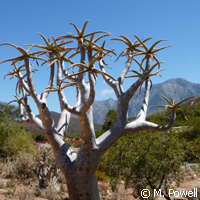Plant life is under threat, but how do we know?
To date, plant species are considered to be at risk of extinction if they inhabit a limited geographical area and have a small population size. But thanks to a new study of a range of plant specimens from South Africa and the United Kingdom, an international consortium of biologists have shown that these criteria wrongly categorise species as at risk when they are newly arrived in an area. Published in the journal PLoS Biology on 4 May, the study has been partially funded by the European Research Council (ERC) under the European Commission's Seventh Framework Programme (FP7) and co-led by Professor Vincent Savolainen, who holds a joint post in the Department of Life Sciences at Imperial College London and Kew Gardens in the United Kingdom. Professor Savolainen and his colleagues collected plant tissues from the Cape Floral Region in South Africa, an area known for its spectacular plant diversity. Molecular analysis of deoxyribonucleic acid (DNA) sequences showed that the pattern of threat differs to that presenting in plants in the United Kingdom with one of the best-studied flora, as well as the pattern seen in vertebrates. 'Our results challenge the application of the same sets of threat criteria across living organisms and across regions,' Professor Savolainen notes. 'We may need to think of ways to fine tune the implementation of 'Red List' criteria for rapid assessments of threat - a daunting task that might prove even more pressing given the changes we see in our global environment.' The Red List is produced every year by the International Union for the Conservation of Nature (IUCN), following extensive field surveys and data collection exercises and building on knowledge gained in previous years. The update of the Red List, published in 2010, describes a staggering 17,390 species - out of almost 50,000 species surveyed - that are threatened with extinction. The number of plants and animals added to the list every year is increasing. According to recent estimates, about 20 % of flowering plants are currently at risk of extinction - though the exact number is unknown, because only a small proportion of plant species has been studied. Many factors contribute to the endangerment of plant species. Numerous species are victims of habitat loss due to land and agriculture development. Others have declined due to pollution or habitat damage, or as a result of competition with invasive species. Still others have succumbed to newly introduced diseases. 'Reducing rates of extinction represents one of the greatest ecological challenges of our time,' says Professor Jonathan Davies from McGill University in Canada, 'but identifying which species are most at risk can be difficult.' The results of the study suggest that a plant species' risk of extinction is closely related to the age of the species. This is different to the factors thought to put animal species at risk. Characteristics thought to increase a species' risk of extinction include traits like having a large body that takes a long time to reach sexual maturity, or a tendency to bear one offspring at a time with a long time interval between births. 'In plants, we show that the processes of extinction and speciation [the evolutionary process by which new species arise] are linked - seemingly the most vulnerable species are often the youngest. Young species may appear at high risk of extinction simply because their populations have not yet had time to grow and spread,' explains Professor Davies. 'However, it is also possible that some plant species might be doomed to extinction from their very inception.' For more information, please visit: Imperial College London http://www3.imperial.ac.uk/ PLoS Biology http://www.plosbiology.org/
Countries
United Kingdom, United States, South Africa

